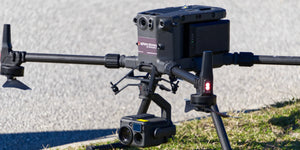Drones are beginning to take up a bigger role in protecting and tracking animals, helping environmentalists do their job. These conservation drones are doing everything from collecting the snot from whales to locating koalas after the devastating wildfires.
Drones in oceanography
Whales play a significant role in the health and stabilisation of the world’s oceans – in life and death. As they live, these wondrous beings act as marine ecosystem engineers, regulating a wide variety of oceanic organisms. And when they die, their massive carcasses sink to the seafloor and provide essential nutrients to deep-sea life.
Add to the mix the fact that these aquatic giants also contribute to the global cycling of environmental resources like carbon, nitrogen, and iron, and it’s easy to understand why environmental researchers around the world are concerned about the conservation and management of this endangered species.
Traditionally, to learn more about the biology and behavior of these majestic creatures, researchers have relied on lethal scientific whaling. But today, to gather biological data from whales, all you need is a drone, Velcro, and a few Petri dishes.
Ocean Alliance, a nonprofit organisation, has been using a modified DJI Inspire 2 drone for drone whale research. The ‘SnotBot’ collects blow samples from whales as they come up to the surface and exhale. These sticky, clear-colored blow samples contain whale DNA, microbiomes, tissue particles, stress and pregnancy hormones, and other viruses, all of which are a telling indicator of the great mammal’s health.
Drones in conservation photography
As the predator-in-chief of their habitat – be it grasslands, scrubs, or open woodland – lions have the all-important role of regulating the food chain and controlling the herbivore population. But with only around 20,000 African lions left in the wild, the king of the beasts has been officially declared as a ‘vulnerable species by the International Union for the Conservation of Nature (IUCN). And given their current rate of poaching and habitat loss, researchers fear that these amazing cats could be completely extinct by 2050.
Historically, the survey methods used to count lions have been very imprecise. Population estimates are based on track counts, audio lure surveys, or expert solicitation of the lions – techniques that are simply not reliable enough to understand how prides are faring over time.
A more promising survey approach, which has been trialed recently, involves taking high-resolution photographs of the lions and capturing their unique whisker print. Yes, just like no two humans have the same set of ridges and lines on their fingers, the number and arrangement of whiskers on a lion’s face are also distinct. And drones have made capturing and recording these unique whisker spot patterns quite easy.
How exactly are drones effective in conservation photography? A small drone, such as the DJI Mavic 2 Zoom, can fly within a few meters of a lion without disturbing them and capture a 48-megapixel super resolution photo with 2x optical zoom. What about the noise? Turns out, once a lion gets habituated to a drone flying in a distance, it thinks that the machine is nothing but a small, noisy bird!
Drones protect wildlife
WWF-Australia describes the Australian bushfires of 2019-20 as ‘one of the worst wildlife disasters in modern history’ and not without reason. The unprecedented fire season consumed over 12.6 million hectares of land across the continent, killing or displacing three billion animals. Of these, more than 61,000 were koalas, the iconic marsupials native to Australia.
Sadly, even before the bushfire crisis, the much-loved koala was considered vulnerable to extinction because of threats posed by hunting, land development, food degradation, droughts, and disease. So, when the fires raged, forest and wildfire officers quickly turned to drones to search for surviving koalas in both burnt and unburnt areas.
In the state of Victoria, the emergency crew flew DJI’s Mavic 2 Enterprise Series drones with high-resolution thermal cameras to detect the heat signatures of the koalas. Once bears were located, the ultra-zoom visual camera on the same drone helped first responders to determine if the animals needed medical attention. For those in need of assistance, cherry pickers were used to fetch them down.
Research scientists in the neighboring state of New South Wales also concurred that wildlife mapping thermal drones were much cheaper and more efficient than using traditional surveying methods such as scat surveys or spotlighting with head torches. This, because, as instantly recognisable koalas may be, they camouflage well and are notoriously difficult to detect.
Source: DJI





















